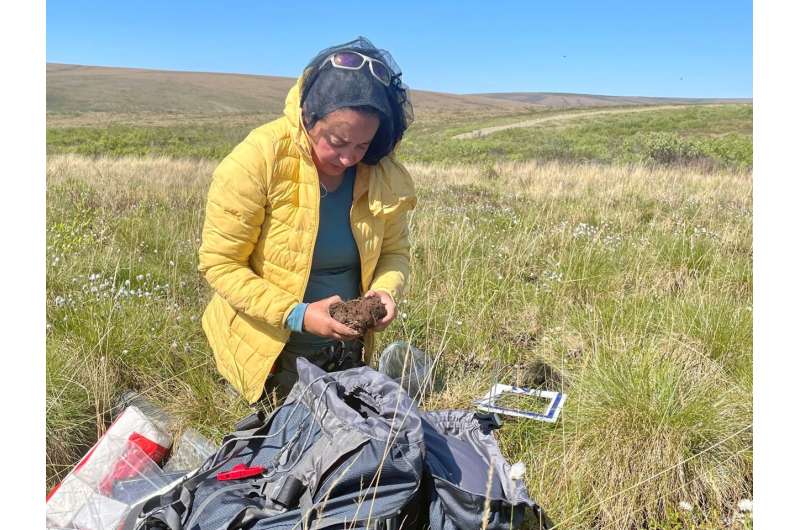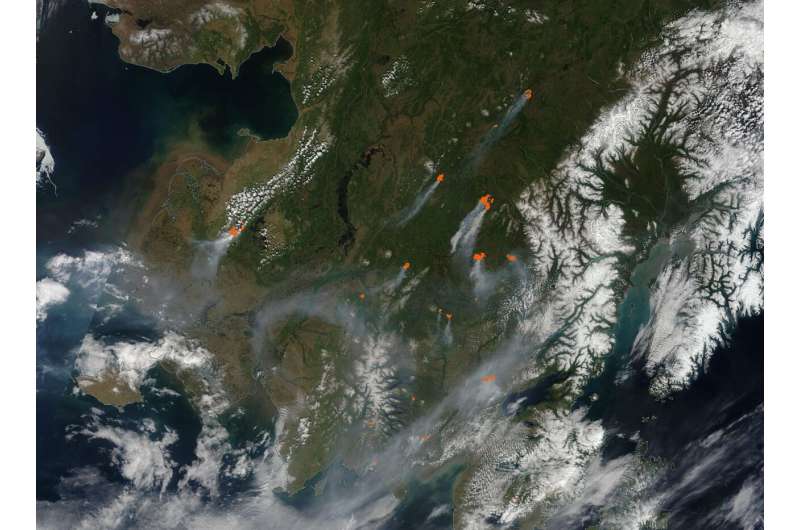This article has been reviewed according to Science X's editorial process and policies. Editors have highlighted the following attributes while ensuring the content's credibility:
fact-checked
peer-reviewed publication
trusted source
proofread
Scientists dig into wildfire predictions, long-term impacts

Wildfires are an ancient force shaping the environment, but they have grown in frequency, range and intensity in response to a changing climate. At the Department of Energy's Oak Ridge National Laboratory, scientists are working on several fronts to better understand and predict these events and what they mean for the carbon cycle and biodiversity.
Two months into the 2023 peak summer fire season from June through August, Canadian wildfires had burned more than 25 million acres of land, disrupted the lives of millions and spread beyond the traditional confines of western Canada east to Nova Scotia. The phenomenon attracted renewed attention as smoke drifted to heavily populated regions, turning the New York City skyline orange and drifting across the Atlantic Ocean to Europe by late June.
Understanding the many risks and impacts of wildfires is at the heart of several projects at ORNL. Henriette "Yetta" Jager, an ORNL scientist whose research sits at the intersection of energy and ecology, has studied how selective forest thinning can both remove fuel for wildfires and provide plant material for conversion into biofuels.
"It's a complex topic," Jager said. "The science is showing that although it may be difficult to remove undergrowth and thin trees in some roadless areas, simply leaving old growth forest alone may cause more harm than good. For at-risk species such as spotted owls, letting fuel build up can cause larger and more widespread fires that can be worse in the long run."
Jager has worked with colleagues to build a framework that can support decision-making around forest-thinning practices, landscape patterns and even spatial firefighting tactics. Results of their work could be used to protect terrestrial and aquatic species that need safe passage to move away from wildfire and then return later.
"Wildfire disturbance is a part of nature, and species are adapted to it, but we're in a different situation now with climate change," Jager said. "There are going to be big shifts in when these fires happen, their size and severity, which will cause big shifts in vegetation and new impacts on animal species. By continuing our research, we can help forest managers plan for these shifts."
Unearthing data in the carbon-rich Arctic tundra
Advancing the understanding of wildfire effects on the carbon cycle is a focus for ORNL scientist Fernanda Santos. She studies not only single events, but also repeated wildfires over decades. She examines what these fires portend for the land's ability to lock away carbon. Conversely, her work also evaluates how fires can become a source of carbon emissions during wildfires and potentially intensify the warming cycle. The world's soils hold more than 3 gigatons of carbon—triple the amount in the atmosphere—and roughly 70% of the top layer of all soils has been exposed to fire at some point.
Her research illuminates the anticipated changes as the land evolves in response to fire. "A lot of people think of evolution as something that happens over centuries," Santos said. "But the idea of rapid evolution, including how plants and soil microbiomes rapidly adapt to increased fires, is relatively new. Will we see more or less biodiversity after repeated fires? Ultimately, we want to know how fire affects these environments, including below ground."

Fire affects plant functional traits as well as the diversity and function of microbes and other organisms in and around the soil that can alter plant and soil quality, Fernanda and colleagues said in a special issue of Functional Ecology examining knowledge gaps in the study of wildfire evolutionary impacts. Changes in wildfire regimes related to a hotter climate, like greater recurrence and severity, have been reported to accelerate the transition from tree- to shrub-dominated ecosystems, for instance. Fire's evolutionary influence can be seen in the selection of plants with traits such as thicker bark and fast germination and resprouting and can result in less plant diversity.
The scientists also pointed to the need for more research into how fire may affect plant-fungal interactions in forests. More severe and repeated wildfire may also impact the sensory cues that animals, including insects, pollinators and herbivores, typically use to avoid fire and result in additional implications for biodiversity in a changing climate, the scientists said.
At ORNL, Santos works on projects like the DOE Next-Generation Ecosystem Experiments Arctic, or NGEE Arctic, performing experiments and collecting observational data to better understand changes happening in Arctic ecosystems. She concentrates on disturbance ecology—what events such as wildfires and pest outbreaks mean for the environment and future climate feedbacks. She examines the organic and inorganic chemistry of the Arctic topsoil, which helps insulate the tundra's carbon-rich permafrost layer.
Refining large-scale climate simulations
Santos is also helping refine large-scale simulations of the Earth's climate, such as DOE's Energy Exascale Earth System Model, to better represent different forms of carbon like charred biomass—soot and charcoal—that result from wildfire. The model runs on the world's fastest supercomputers, providing highly advanced simulations to better predict environmental change that could affect the energy sector.
All of that work depends on the quality and quantity of observational and experimental data. To enhance wildfire- related datasets, Santos and ORNL colleague Jiafu Mao have launched a Fire Community Database Network to encourage scientists and land managers to submit environmental data on burned areas to a central repository. Sharing such information can not only improve research, but also inform land management practices, the scientists said.
Wildfires consume not only the biomass of plants and trees, but can also result in the release of carbon that has been stored in soils for years or centuries, Santos said. "Our work in the Arctic is focused on a better understanding of what may happen in these carbon-rich soils in higher latitudes like Alaska and Canada. We model and predict the land carbon cycle, and I'm focused on helping decrease the uncertainty in those models with field data about historical fires."
More information: Fernanda Santos et al, The eco‐evolutionary role of fire in shaping terrestrial ecosystems, Functional Ecology (2023). DOI: 10.1111/1365-2435.14387
Journal information: Functional Ecology
Provided by Oak Ridge National Laboratory




















